August 2, 1876, Nuttal & Mann’s Saloon No. 10, Deadwood, Dakota Territory. A tall, long-haired, well-dressed man lay dead on the floor next to a blood-splattered gambling table. Only a moment before he and his companions had been playing poker. As a general rule, the dead gambler sat with his back to a wall to prevent assassins from creeping up behind him, but this time that seat was occupied by another gambler who had refused to move. On the table still lay the deceased gambler’s dealt cards. Over time, a legend grew that before his murder he had held pairs of black aces and eights, a selection that became known as the “Dead Man’s Hand.”
Bystanders, some of them probably drunk, couldn’t believe what had happened. A cowardly wretch named Jack McCall had slipped unnoticed behind the now dead gambler and shot him in the back of the head.1 The bullet ripped through the unwary victim’s head and buried itself in the wrist of another card player.
crime and punishment
What shocked the stunned onlookers was the identity of the deceased: he was one of the West’s most celebrated gunslingers. His name was James Butler Hickok, better known in the newspapers and blood-and-thunder dime novels as Wild Bill Hickok.2 He was only thirty-nine years old.
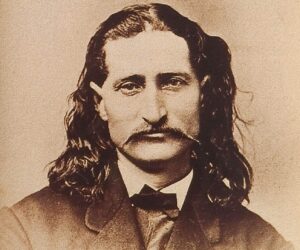
Quickly acquitted by a local “miners’ jury”, McCall started bragging that he had gotten away with murder. Upon hearing those boasts, the authorities rearrested him. Because of the irregularity of the first trial, it was decided that a second trial in Dakota Territory’s federal court in Yankton would not constitute “double jeopardy”. Once again, McCall faced a jury and this time he was found guilty of murdering Hickok. Several months after the verdict he was “jerked to Jesus”.3
the dangerous frontier
In this late stage of the American frontier there was no shortage of very cold-blooded killers who were willing to murder a renowned person to achieve sudden fame–or for no reason at all.
Post Civil War Texas cattle herded north into Kansas dumped a number of reckless, pistol-packing cowboys into small towns that were not able to cope with their rowdy drunkenness. Moreover, the recent Civil War had produced a surplus of violent men who were not done with fighting and who migrated west where they felt less constrained. Some of those men became feared outlaws who had little opposition because law enforcement in remote places was generally very thinly spread, frequently incompetent, sometimes on the take, or nonexistent.
However, some cow-towns mayors and city councils decided to fight fire with fire and hired, on a temporary basis, the most feared gunmen available to scare off the other bad guys.4 One such hired hand was Wild Bill Hickok. Yet despite his awesome, though inflated, reputation, Wild Bill was known to be courteous and fair, but firm, with his adversaries. They knew—or should have known–that he meant business, though some mischief-makers pushed their luck too far, much to their regret.
the stuff of legend
Well-deserved criticism can be levied against today’s news media’s focus on the sensational and trivial but the mid to the late nineteenth century American press was far worse. Adding to that were dime novels that grossly embellished the exploits of well-known figures, particularly Westerners, to the delight of their gullible audiences.
Invariably, Hickok was cast as a farfetched action hero who had outfought and killed hundreds of badmen (and large dangerous creatures) all by himself.5 Yet even if one discounts all the lurid claptrap written about Wild Bill, he truly did live a perilous and thrilling life. During his short lifespan he was a teamster, Civil War policeman for the Union Army’s provost marshal in Missouri, Union Army contract scout and spy against the Confederacy, postwar government detective, scout for Lt. Colonel Custer, sheriff, Kansas cow-town lawman, U.S. Deputy Marshal, disgruntled actor in Buffalo Bill Cody’s amateurish stage plays about the Wild West, and then, because of his fading health, fulltime gambler.
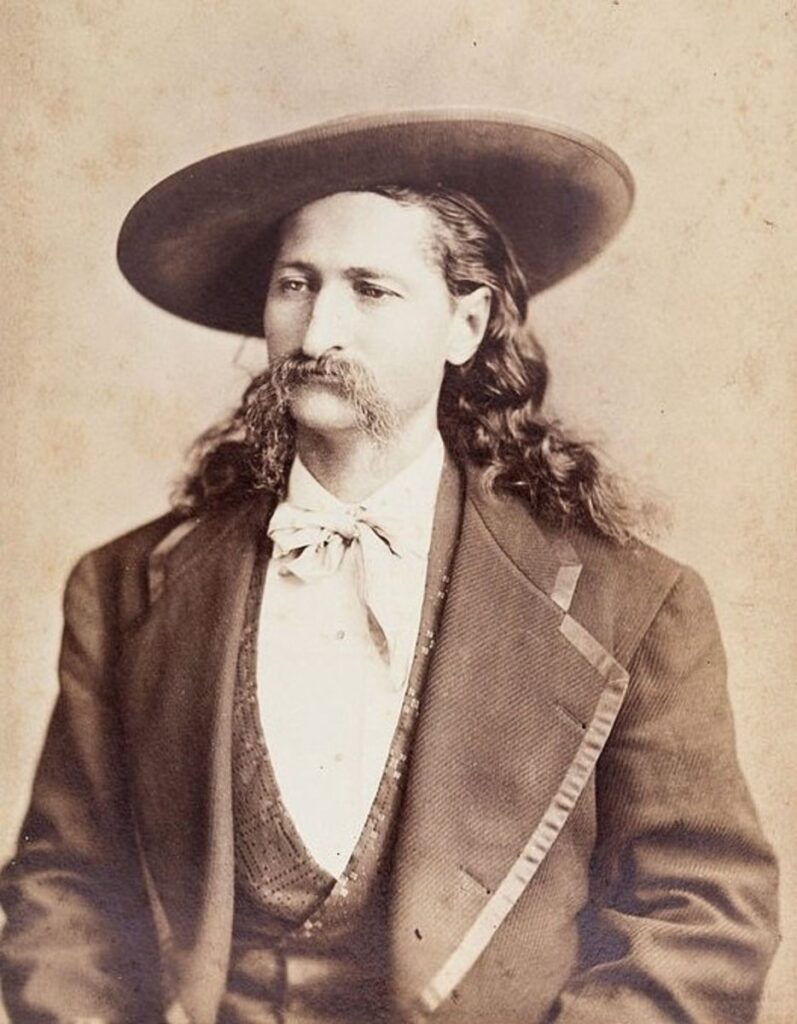
Professional gambling was a comfortable fit for Hickok because he had engaged in it for most of his life. It was relatively safer too–when playing the cards, he didn’t have to face down inebriated, revolver-waving cowboys and homicidal maniacs like he did as a town marshal. That is, until he came into contact with the chicken-hearted Jack McCall.
software and hardware
Perhaps Wild Bill’s best-known face-to-face shootout took place in Springfield, Missouri, in 1865 when he faced off with Dave Tutt over an argument about a small debt. Depending on who was recounting the event, the two antagonists were about seventy-five yards apart when Tutt fired first and missed, and then was shot in the heart by a coolheaded Hickok with one of his trusty Colt Navies. And it appears that it was always his Colt Navies that he used as a lawman after the Civil War. This particular shooting may have inspired the later Western shootouts at high noon so beloved by Hollywood.
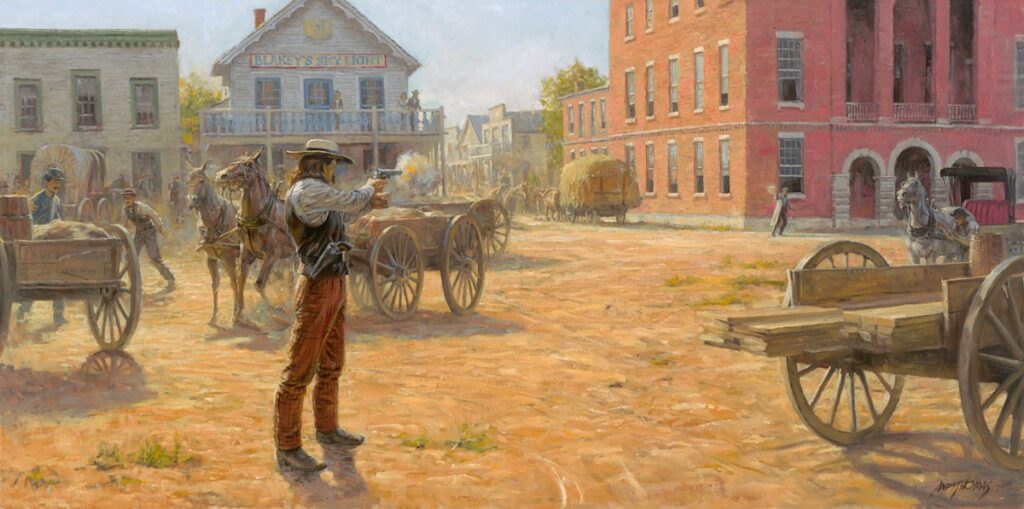
Hickok was best known for carrying twin ivory-handled .36 Colt Navy percussion revolvers cross-draw style either in a sash or in open-top holsters on a heavy belt around his waist. Firearms technology was rapidly changing during the Civil War and soon after, in particular with production of metallic cartridge ammunition. So, did Wild Bill make the change and buy any then-new metallic cartridge revolvers, or was he satisfied with his percussion handguns?
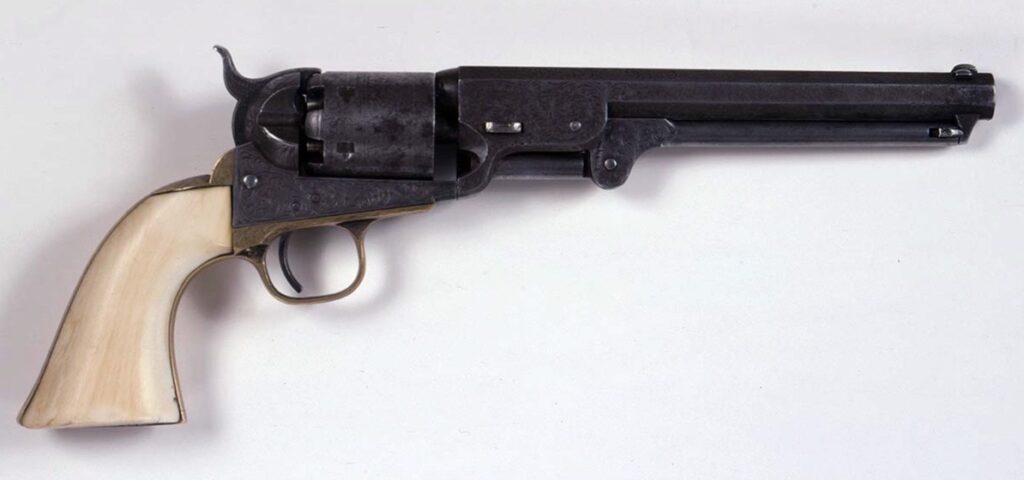
The transition from percussion handguns to metal self-contained cartridge-firing revolvers after the Civil War was not instantaneous.6 Colt continued to manufacture its Model 1851 Navy until 1873, when it was replaced by the famous Single Action Army revolver. Even though metallic cartridge guns were quickly taking over the market, a significant number of gun owners stayed with the percussion system for a while. For one thing, they knew their firearms well and some owned bullet molds that allowed them to cast their own bullets from bar lead. All they needed to buy was gunpowder and percussion caps, making it cheaper to shoot percussion firearms. Also, the new metallic cartridge ammunition, still in its infancy, wasn’t all that reliable. The early versions were made of copper and were rimfire, and “had a tendency to jam” in the firearms’ chambers. They were quite expensive too, all the more reason for percussion firearms owners to stick to their guns. Or at least until the improved brass centerfire cartridges were developed and on the market.
the Indian, not the arrow
Whatever his reasons for using Colt Navies, Hickok was noted for meticulously loading them and keeping them in good order. Frequently, he fired off all the chambers of those guns so he could thoroughly clean the weapons and reload them with fresh black powder and new percussion caps. It was his conviction that his handguns had to be in tiptop shape and always ready. His life depended on it.
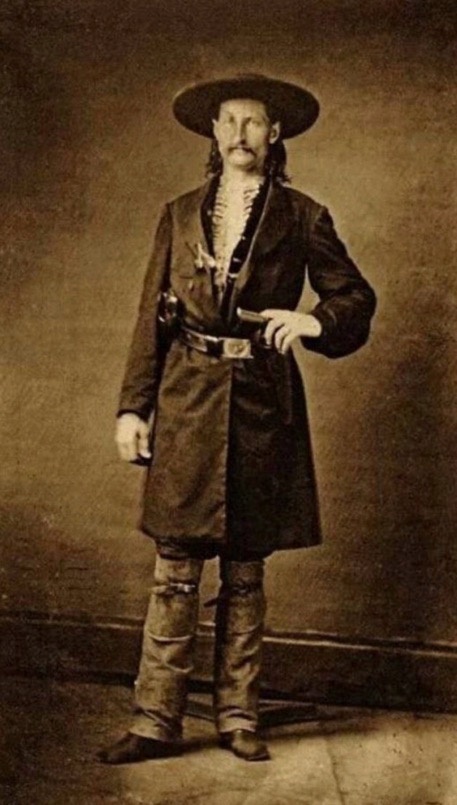
Many accounts of Wild Bill’s shooting skills were exaggerated in the press, but it was well known that he regularly practiced with his Colt Navy revolvers and was an excellent shot.7 He was also known to have the unusual ability to remain calm and focused while encountering imminent violence and take quick but careful aim with his revolvers to hit his mark. Despite its rudimentary sights, the Colt Navy was accurate and reliable when well maintained and properly loaded. The Navy’s .36 ballistics wouldn’t stack up very well to today’s high velocity magnum handguns, but for a precision shooter like Wild Bill Hickok they were just the ticket.
a convert?
Is there any evidence that Hickok, near the end of his life, had his Colt Navies converted to shoot metallic cartridges?
An ivory-handled Colt Navy currently residing in the Buffalo Bill Museum of the West apparently was one of the pair that Wild Bill carried as a lawman and looks to be still in its original percussion form.8 So does its alleged mate, which was up for sale by Rock Island Auction in July 2022. If Hickok owned another Colt Navy, or a pair of them, that had the cartridge conversion it’s not showing up in any of the sources I’ve located.
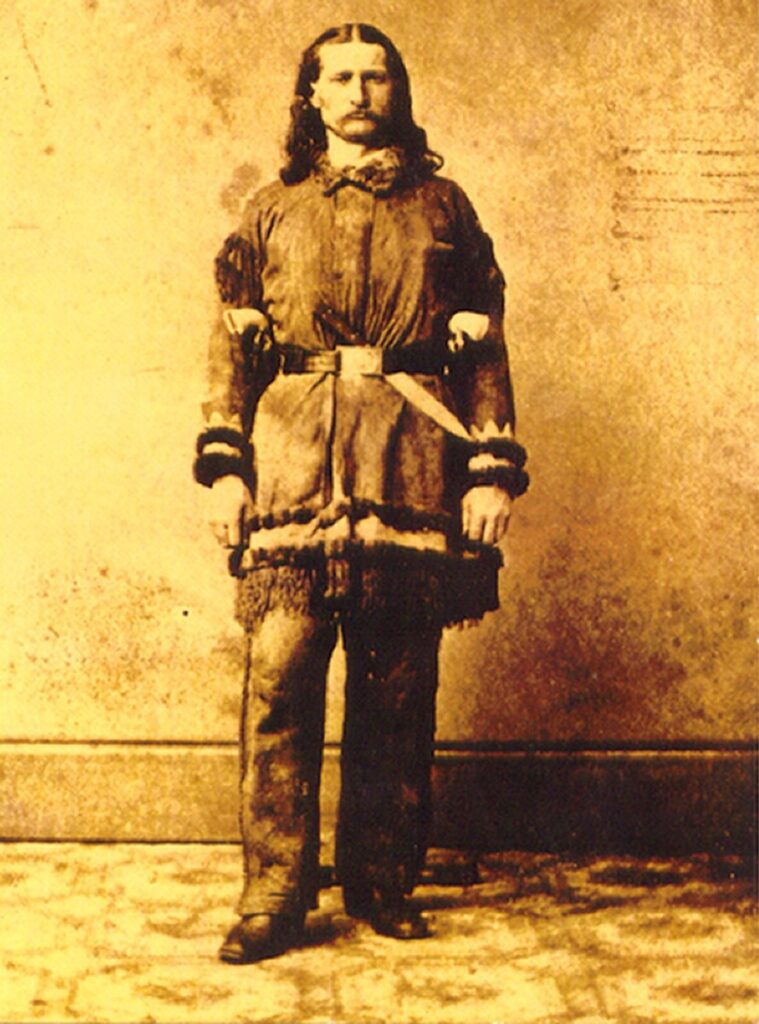
But did Hickok own other handguns besides his Colt Navies? At the scene of his assassination by the craven McCall, a .32 rimfire, five-shot Smith and Wesson Model 2 was found on Hickok’s person. Although the Model 2 was not as potent as a Colt Navy, it wouldn’t have made any difference at the card table in Deadwood if Wild Bill had been armed with the larger Colt revolvers. He apparently never saw McCall sneaking up behind him. He was also going blind.9
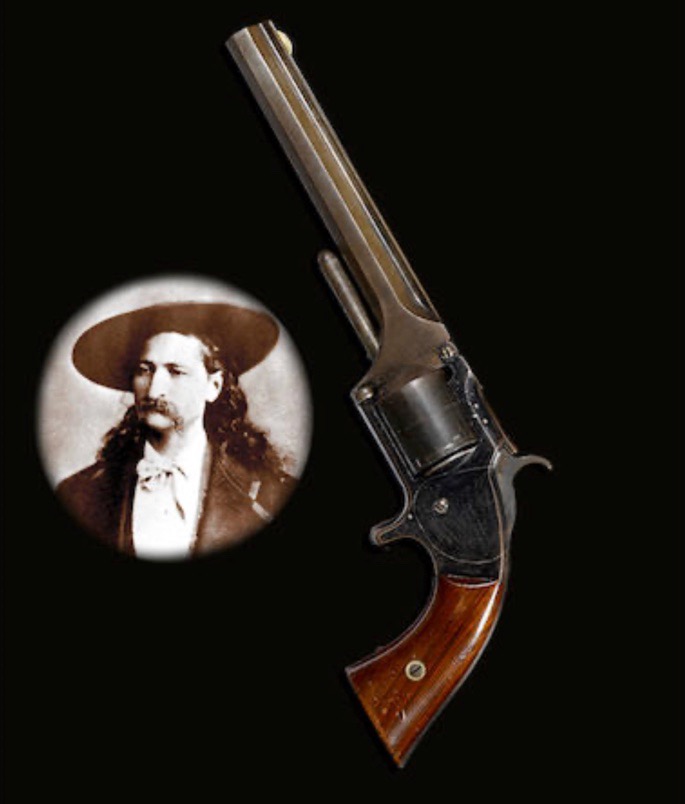
The late writer Joseph Rosa is credited with being the authority on Wild Bill Hickok and did a fine job of separating the man from the myth. His research revealed that Hickok also owned a.44-caliber Colt Army Model 1860 that was converted to fire metallic cartridges. At Hickok’s departure from Buffalo Bill Cody’s play in 1874, he was gifted with “a pair of .44 Smith & Wesson American revolvers”, also designed to fire metallic cartridges. Neither the Colt Army Model 1860 nor the Smith and Wesson revolvers appear in any photos of Wild Bill, or later accounts of his “waist armory”, but maybe he didn’t like to carry them. Both guns were heavier than the Colt Navy.
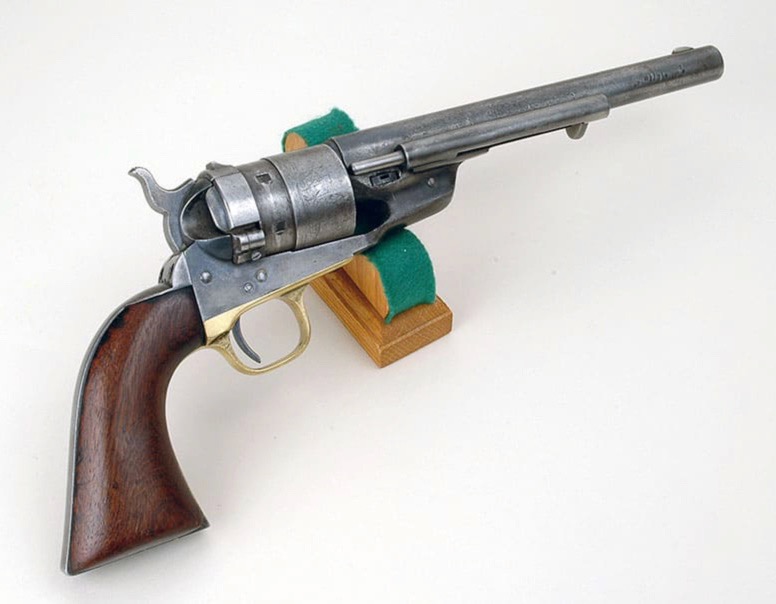
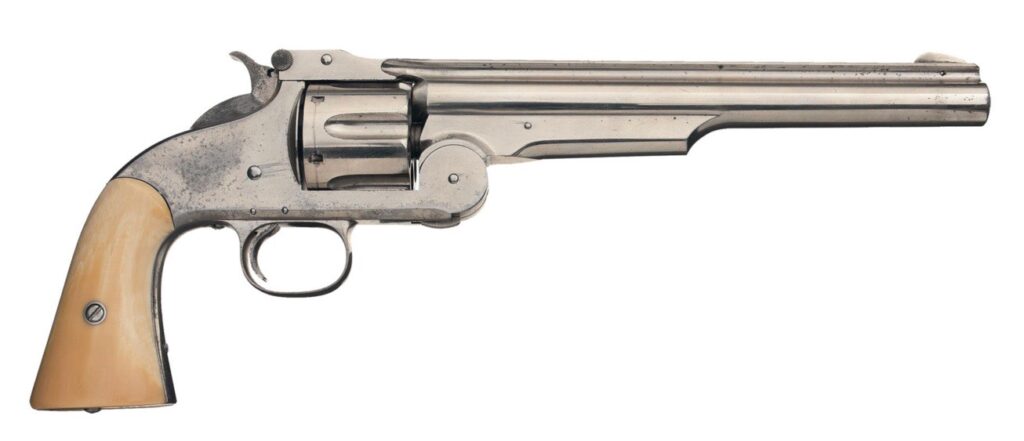
In addition to Hickok’s Colt Navies, he was reputed to carry .41 Williamson Derringers while patrolling cow-town streets. Those were single-shot hideout guns with tip-up barrels that would have been useful backup pieces. He may have stashed them in his pockets while gambling where they could be handy in case of a ruckus. Many gamblers, and prostitutes, of that era carried hideout guns and knives to protect themselves against enraged sore losers.10 Which was probably was why Wild Bill had a Smith & Wesson Model 2 hidden in his clothes when he met his tragic end. Unfortunately, that weapon didn’t help him.
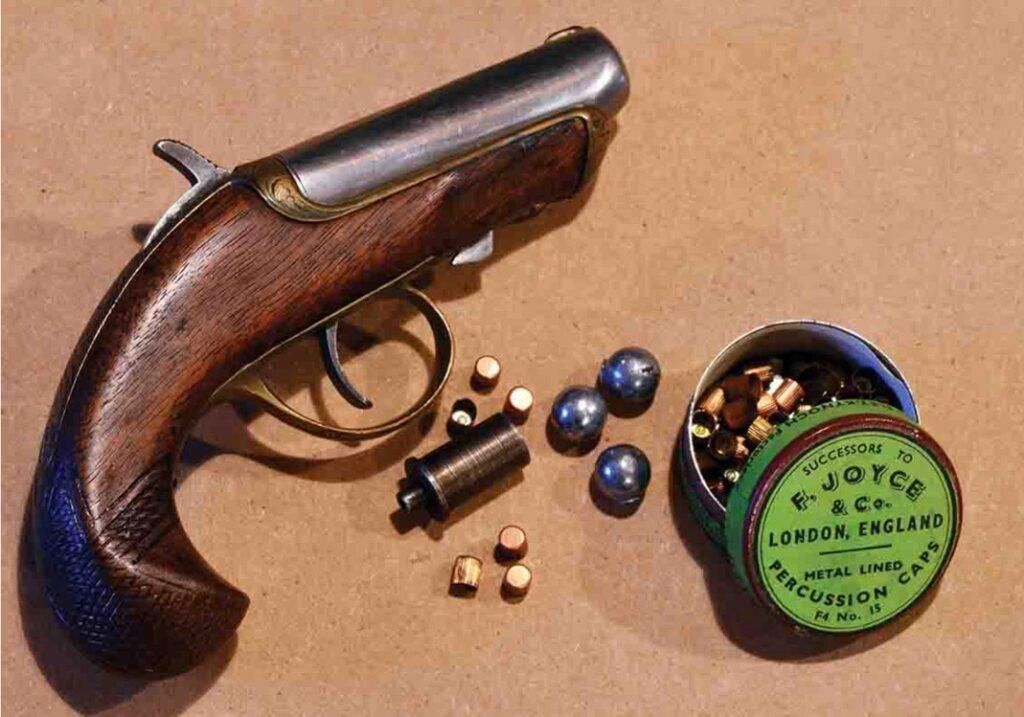
fact, not fiction
Now that it’s been about 150 years since Wild Bill’s death, it’s time to put to rest the absurd number of deaths attributed to him. He probably killed no more than ten men, but most were armed and trying to kill him.11 The steely-eyed Hickok was the superior marksman and he put them down. His Colt Navies served him well in that capacity but he was not financially flush at the time of his death. Consequently, his two Navies were sold to help pay for his funeral expenses.
Wild Bill Hickok was a staunch law-and-order fighting man who met Western badmen on their own terms and vanquished them. Quite a few of his detractors—some of them the same bedwetting mayors and merchants who had hired him to scare off desperados and thugs—may have been jealous of his fame and knew they lacked his courage and fighting skills. Even so, Wild Bill was aware that the American frontier was nearing its end and so was the need for anachronistic gunfighters like him. With his health in decline, Hickok may have wandered off to Deadwood to finish out his life while the Wild West was also waning. Yet his fame continues to the present.
*****
Endnotes:
1.) Several theories quickly arose about the reason for McCall’s crime. He alleged that he had taken revenge on Hickok for killing his brother, then later claimed he was paid by another gambler to kill Hickok because of a disagreement. The likely reason for the murder was tinhorn McCall was enraged about a recent gambling loss to Hickok.
2.) Hickok may have started using his father’s name, William Hickock, in the late 1850s for reasons unknown. By the time of his shootout with Dave Tutt, Hickok began calling himself “Wild Bill” and so did the newspapers. There were dozens of Wild Bills in the West then (and several “Buffalo Bills”). Adding to the confusion, news reporters and writers of that era couldn’t agree on the spelling of Hickok’s surname: Hickock, Haycock, Hitchcock, and Hickox appeared in newspaper articles and journals. He was also called “Duck Bill”, “Dutch Bill” and “Shanghai Bill”, but “Wild Bill” stuck.
3.) About five years after his hanging, Jack McCall was disinterred and the noose was still fastened around his neck. It seems not even the hangman had any respect for McCall.
4.) Much later, when the towns were no longer riddled with criminals and rowdies, some of the local politicians failed to mention that they had intentionally hired gunfighters to be their towns’ protectors. Even so, law enforcement in those towns was generally seasonal; when the cattle drives were done for the year, the lawmen were let go.
5.) The rough-and-tumble Hickok was no stranger to using physical force on out-of-control jackasses to maintain the peace. Once he knocked down a cretin who’d insulted a woman and then boot-stomped him in the face. Another time, while serving as a town marshal, he whacked an unruly cowboy on the head with his revolver and then kicked him in the face. In New York during his acting tour with Buffalo Bill Cody, Hickok punched out a belligerent horsedrawn cab operator. Undoubtedly there were many other similar incidents that didn’t get recorded for posterity.
6.) In fact, percussion firearms never really died out–they’re still being made today.
7.) One of the duties of the frontier lawman was to shoot stray dogs, probably to prevent the spread of rabies.
8.) I sent an email to the museum about this topic on February 14, 2024 and am awaiting a response.
9.) For several years late in his life, Hickok was bothered with eye problems. During his short time on the stage with his friend Buffalo Bill Cody and cast, he complained about the bright stage lights hurting his eyes. One time, he shot out a theatre light that was bothering him. Modern medical experts conjecture that he may have suffered from trachoma, glaucoma or the effects of tertiary syphilis.
10.) Gamblers then were called “sporting men” and prostitutes “sporting women”.
11.) Tragically, one of them was a fellow lawman who had rushed in to the scene whom Wild Bill accidentally shot a moment after his gunfight with Philip Coe in Abilene, Kansas, in 1871. Distraught over the unfortunate death, Hickok didn’t serve again as a peace officer. That was also his last gunfight.
Sources:
Di Certo, Joseph J., “Wild Bill Hickok: American Frontiersman”, https://www.britannica.com/biography/Wild-Bill-Hickok.
Newman, Warren, “Hickok and His Guns: How Good Were They?”, Points West Magazine, Spring 2003.
Oliver, Mark, “The True Story Of ‘Wild Bill’ Hickok, From Blood-Soaked Gunfights to The ‘Dead Man’s Hand’”, https://allthatsinteresting.com/wild-bill-hickok, October 5, 2021.
Rosa, Joseph G., “Weapons of A Pistoleer: Wild Bill Was Well-Armed”, HTTPS://WWW.HISTORYNET.COM/WEAPONS-PISTOLEER-WILD-BILL-WELL-ARMED/“, May 9, 2018.
Rosa, Joseph G., The Gunfighter: Man or Myth?, University of Oklahoma Press, c. 1969.
Rosa, Joseph G., Wild Bill Hickok: The Man and His Myth, University Press of Kansas, c. 1996.
Trimble, Marshall, “The Metallic Cartridge”, https://truewestmagazine.com/the-metallic-cartridge/, True West Magazine, November 8, 2021.
Trimble, Marshall, “What Pistol did Wild Bill Hickok Favor?”, https://truewestmagazine.com/article/what-pistol-did-wild-bill-hickok-favor-2/. True West Magazine, April 1, 2007.
Credits:
Lead image is one of Wild Bill’s Colt Model 1851 Navy revolvers, in the collection of the Buffalo Bill Center of the West Museum. Image from: https://centerofthewest.org/2019/12/20/treasures-wild-bill-hickok-revolver/

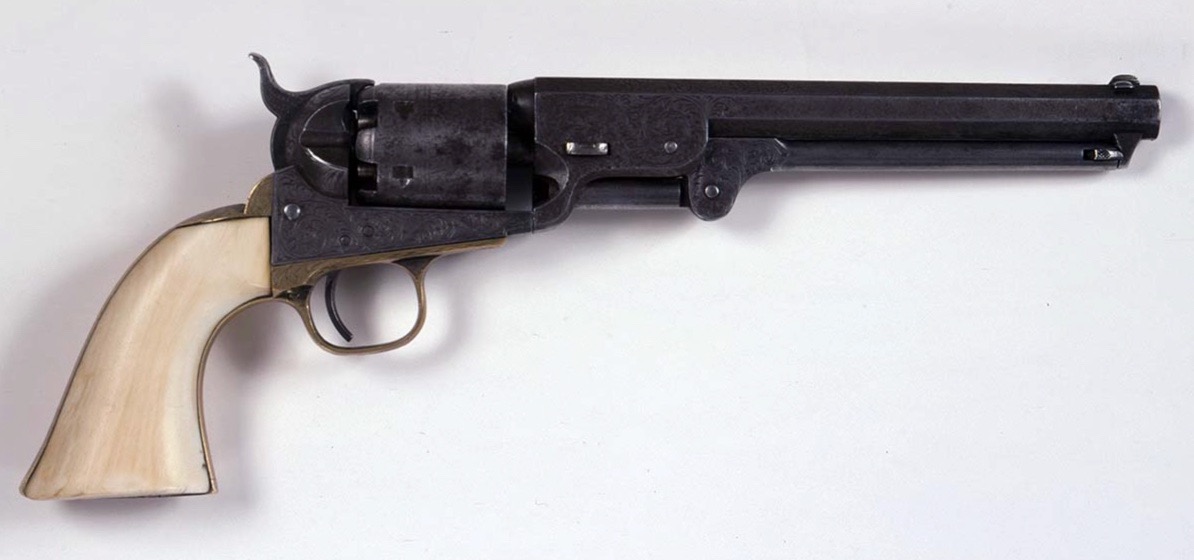
Great piece! Makes me want to read more about this fella!
Wild Bill could fill his own library on his life and times. ,1 thing I read was he shot the center of an Ace of Spades the was either one hundred and fifty feet or one one hundred and fifty yards the shot was dead center. I was amazed don’t know if I would like to have met him he seemed a bit on the violent side.
Thank you George Marcrum.
Great article Sir! You did a fine job with this story. I think many people overlook the traits and habits of these historical figures and they don’t take them into consideration when applying logic to today’s threats and technology. What I mean by that is, Wild Bill had the reputation of being “coolheaded” as you described him. He didn’t seem to concern himself with the latest and greatest weapon developments when choosing his armaments. He stayed with what he knew, practiced with them, and kept them in top working order.
I think too many folks these days think as long as they have a hi-cap whatever, and 50rnds of amnunition at their disposal, they are ready for anything. Practice, maintenance, and the “coolhead” are too often overlooked. Great job and thank you for bringing this story to us.
Indeed, Mark. We’re lucky to have Clay contributing his talents and energy here. I’m very grateful!
Your observation is excellent, and important for all of us to remember.
It’s the Indian, not the arrow!
Great points, Mark. I’d be a lot more worried about a well-practiced shooter with a revolver than someone who only takes their G19 to the range once or twice a year.
A great Saturday morning read over coffee. Thanks for the history!
Thank Clay for another good one. You are spot on about the popularity of the Colt Navy even after the advent of the metallic cartridges.
Chief Deputy Sheiff Everett Wheeler went to a house in a rural area of Independence county, Arkansas on Jaunuary 2nd 1935 to arrest a fugitive. The man ran out the back door where Weeler was waiting and shot and killed the Deputy.
The bad guy’s weapon of choice, a Colt 1851 Navy. The revolver
used that day was put in to production 84 years earlier. Unfortunately in this case it worked well. Robert Rose, the killer, tried out a new fangled invention, the electric chair only 51 days after thepunishment.
Swift & sure punisment.
Folks didn’t throw away things that still worked in these old Ozarks and didn’t much trust those new fangled contraptions.
Thank goodness that new chair with wires worked just fine.
Keep em coming.
“The irregularity of the first trial” is an understatement. In 1876, Deadwood was an outlaw town, because it was on Indian land, and nothing about it was legal. The land deeds were illegal, the town offices and officers were illegal, and any court proceedings were illegal. Where McCall screwed up was in bragging on a train within earshot of a Deputy U.S. Marshal. The deputy arrested him and took him to a real court, and the rest is history.
Am I a bad person for laughing out loud when I read “jerked to Jesus”? Never mind, I already know the answer.
This is a great story, and even to someone who knows the basic story, the details here are fascinating. Keep hitting them out of the park.
I was in the process of asking a question about the Williamson Derringer when I actually read the caption and found the answer. My question was, does (did) it fire the same .41 round as the Remington stackbarrel? Apparently, it does. It’s probably a good thing Wild Bill never shot anyone with that pathetic thing. According to the interwebs, it fired a 135-grain bullet at anywhere from about 375 to 450 fps muzzle velocity, and generated about 80 foot-pounds of muzzle energy (somewhere between a .22 Short and a .22 LR). I’d venture a guess that that round killed a lot more people in Hollywood than it did in the Old West.
Or sepsis killed them days after being shot with it.
Great article! I’d never heard this story before.
I can relate to Hickok keeping his percussion revolvers. It takes a while to get comfortable with something upon which your life depends. Sounds like Hickok worked with his revolvers a lot. If it ain’t broke don’t fix it. I have been a police officer for a long time. I carry a snub nose revolver and have since I was first commissioned. For the last 25 or so years I just carry the revolver off duty and as a second gun at work. I practice and I hit what I shoot at…even with my “antique” gun. It took a long time to get confident with my j frame. If it ain’t broke don’t fix it.
Keep up the good work!
Excellent comments, folks!
Because of his itinerant lifestyle, Wild Bill Hickok probably did not own a large arsenal of firearms, or much of anything other than his clothes and small personal items. What he did possess it seems he took good care of it, especially his handguns with which he practiced a lot. He sometimes engaged in friendly shooting matches with acquaintances who occasionally beat him. However, none of the winners thought they’d stand a chance of winning a face-to-face gunfight against Wild Bill . The man had ice water in his veins, took the extra second to line up his sights, and drilled his adversaries.
What comes out in the newspaper articles, diaries and anecdotal stories of the era is Hickok was not a braggart or bully. He approached miscreants (who usually were drunk) in a polite but firm manner and expected them to comply with his requests. When they didn’t he was more likely to jackhammer them with his fists and feet, but if gunplay was required he would quickly segue to that. Hickok was known to be a fearsome punchout artist.
The Colt Model 1851 Navy was a very popular revolver in the day, and probably remained so well after metal cartridge revolvers came into vogue. That revolver offered good accuracy, reasonable size, weight and portability for many Westerners. It might not stack up well in terms of firepower against our modern handguns and cartridges but for many frontiersmen, and maybe more than a few frontierswomen, it did the job. A lot of badmen were shot dead with those Navies, and if they could talk today, they would probably agree that the Navy was serious bad medicine in skilled hands.
An ancestor of mine who was known as “Captain Jack” (his real name was Jackson Cureton) was a Texas Ranger captain during the Civil War and a postwar sheriff in Texas. He favored the Colt Model 1851 Navy and undoubtedly used it to keep the peace and defend the Texas frontier from Comanche attacks. Apparently he was a secret vigilante and may have used his Navy during extra-legal activities.
Agree that if something works there’s no need to get rid of it. The vast majority of my firearms are at least 75 years old and do everything I need them to do. Still, the Williamson Derringer, shown in the article above (or many others of that ilk), would not be my first choice as a hideout gun. But the technology of the day was limited to black powder and softer steels that couldn’t handle heavy loads in small handguns. Yet those tiny guns shot soft lead bullets that may have badly mashed whatever they hit and stopped an aggressive act. Probably more lethal were the edged weapons that many Wild West gamblers and prostitutes carried: ice picks, dirks, push daggers, and Bowie knives of all sizes.
Dark humor was common in the West of the 1800s. Vigilantes would “invite” their miscreant guests to “a necktie social” and made sure their victims became permanent members of “the uplift society”. Census takers of the era sometimes described prostitutes as “horizontal workers”, “ceiling gazers” or “she diddles”.
Wild Bill Hickok is my favorite nineteenth century gunfighter/lawman. He wasn’t a perfect man by any means; he did frequent prostitutes, gambled and drank alcohol (but wasn’t an alcoholic) as did most of his contemporaries. But he was a very brave and martially skilled lawman with whom bad guys understandably feared to tangle. Nevertheless, Wild Bill was not a fool, he knew that there were Texas cowboys who would bushwhack him in dark alleys at night. He avoided those places and always kept his back to the wall in saloons. That practice served him well until a fellow cardplayer refused to give up a wall seat to him in Deadwood, Dakota Territory, in 1876.
Come for the articles, stay for the comments!
Thanks for the additional info, Spencer, which is just as engaging as the article!
Dear Spencer,
I hope you’re doing well. I wanted to follow up on something you mentioned regarding Wild Bill Hickok—that he “frequented prostitutes.” I’m genuinely interested in understanding the basis for this claim. Could you clarify what evidence supports it?
Are you relying on specific primary sources, such as letters, eyewitness accounts, or court records? Or is this based more on historical inference drawn from the social context of the time? Additionally, is there any documented evidence that Hickok was sexually involved with women, or is that conclusion more speculative?
Given how much myth surrounds frontier figures like Hickok, I’m trying to separate popular legend from well-supported fact. I appreciate any sources or insights you can share.
An interesting point was raised by Old 1811 regarding Deadwood in 1876 being an outlaw town on Indian land, and indeed it was. Deadwood was situated in then-Dakota Territory which was Sioux tribal land awarded to them by the U.S. government via the 1868 Treaty of Fort Laramie. Whites were not supposed to be there, but when gold was discovered in the Black Hills all bets (and treaties) were off.
Some historians theorize that when Deadwood’s “miners court” acquitted Jack McCall of murdering Wild Bill Hickok in cold blood they did so because they didn’t want to draw attention to the town’s illegality and bring the federal government down on them. That theory makes sense to me.
For those who enjoy historical fiction, post-Civil War Deadwood and Wild Bill Hickok, Pete Dexter’s novel “Deadwood” and the HBO TV series of the same name are fine interpretations . One segment of the TV version features Hickok (played well by actor Keith Carradine) and his senseless murder by the infamous Jack McCall (convincingly portrayed by actor Garret Lee Dillahunt).
Springfield, MISSOURI
You’re correct, Brian– the Hickok-Tutt shootout was in Springfield, Missouri. Not sure how I goofed up on the location but clearly my mistake.
An excellent summary read of a larger-than-life historical figure! Also, enjoyed the pictures and the information about the guns used. Well done, sir.
According to “I buried Hickok: The memoirs of White Eye Anderson” Hickock was carrying conversion Navy Colts at the end of his life. It makes sense to me having shot percussion revolvers in the rain. 38 RF made by outfits like Union Metalic Cartridge or United States Cartridge Company would have been far more reliable than caps and powder. Hickok emptied his guns because the hygroscopic gun powder would draw moisture from the atmosphere. A crimped and lubed RF round would be far less apt to do this.
Makes sense, Brett. Thanks for the reference!
I agree, Brett. A shootist like Wild Bill probably would want to update his existing hardware to the latest technological improvements. A lot of people did so during that transition period between percussion and purpose-built metallic cartridge handguns and continued to use them for a long time. Many kept using those firearms in their original cap-and-ball forms.
Interestingly, the old and modern photos I’ve seen of Hickok’s known Navy Colts don’t seem to show any modifications to metallic cartridge ammo. The Buffalo Bill Center of the West never responded to my inquiry on that topic concerning the Hickok Navy Colt in their possession. However, I just noticed in Joseph Rosa’s article mentioned in my sources that he affirmed that Wild Bill indeed “carried a pair of .38-caliber Colt Navy revolvers converted from percussion to accept either rim- or center-fire metallic cartridges.”
At the time of his death, Hickok apparently was not financially flush and some of his firearms were sold to pay for his funeral. Maybe those allegedly converted Navies were sold then and never came to light again. For now it’s still up in the air whether Wild Bill’s Navies really were converted. Either way, the man was a deadly shot with any kind of revolver.
Great article. There are two markers on the square in Springfield Mo where Tutt and Hickok were supposed to be standing when they had the quintessential meet in the street and go for your gun shootout. Allegedly the only documented “wild west” shootout to occur.
Whoops was going to add. It’s pretty impressive to see how far apart those markers are.
Jason
Appreciate your in-person impressions of the physical layout of that famous ballistic encounter, Jason, which back up the statements of witnesses to the event. It all adds credence to Wild Bill’s impressive marksmanship and coolness under extreme pressure.
After the Springfield shootout, many a badman learned about his reputation and didn’t dare challenge him to a face-to-face showdown. And the ones who were slow learners, well, in certain circumstances Hickok had a ready answer for them.
Supposedly Hickok and Tutt had been friends before their shootout but it seems that a gambling debt, liquor, and bad sportsmanship led to a terminal ending of their relationship.
Thanks for the good read, C. Spencer. Hickok was obviously a man of discipline and martial prowess. His 1851 Navy in its original cap and ball configuration would (at best) rival a modern .32 H&R Mag ballistically: sending 90-ish grain round balls at around 875 fps? Hickok wisely depended on shot placement to prevail in his dust ups, a good lesson for us to heed. It would make sense that he would fire that 1851, clean it, and reload it literally every day to maintain its’ reliability. As mentioned here, humidity will render percussion guns quite untrustworthy in short order. Hunting with a muzzleloader has taught me that the hard way, loud clicks instead of bangs filleth the freezer not! He paid for his lapse in his normal cautious habits with his life- another lesson to remember. It probably made him crazy to have his back to that room playing poker that night. Rightfully so.
Those are all insightful points you raised about Wild Bill, Kevin. People who knew Hickok firsthand commented about how careful he was with his waist armory, his regular revolver practice with an emphasis on accuracy instead of speed, and avoiding situations that could lead to an ambush. If only that gambler in Deadwood had agreed to change seats for him then Jack McCall probably would not have had to fret about his eventual rendezvous with the hangman.
I was glad to see your comments about metallic cartridges not immediately rendering the cap and balls obsolete. One of my great-great grandfathers immigrated from England in 1976 na d wound up in Nebraska practicing medicine. He was apparently a member of the Nebraska State Guard and had acquired a presumptive Civil War issued 1860 Colt. No idea where or how he got it, but it stayed in the family. He took it to Kansas later when he set up practice in the NW part of the state. To my knowledge based on what my grandfather had told me , the gun had last been fired around the early years of the 20th century when kids were rummaging thru grandpa’s trunk, found the Colt, and ventilated the wall. No one was harmed, fortunately. But it had been stored loaded and remained that way for I’m guessing 15-20 years. No stories of posses, battles, or gun fights so I’m guessing shooting was not the central focus of a frontier doctor. Anyway, from what I remember seeing it and handling it as a kid, it came with a leather scabbard that was relatively simple similar to pictures of holsters I’ve seen from thst period. Anyway, great article!
Thanks, Rob. That’s quite a story about your great-great grandfather and his Colt! (He must have immigrated to the US in 1876, a momentous year for our country when Wild Bill was murdered and George Armstrong Custer and about half his command were wiped out when they attacked a large Northern Plains Indian encampment that was minding its own business. It was also when our nation’s Centennial Exposition opened.)
I hope someone in your family has written or will write a story about your ancestor (and others), and has preserved the Colt. Over time, memories fade and disappear and artifacts grow legs and wander off.
Thanks for a well written and well researched article!
I once read about an interview that Bill Cody gave regarding Hickok and what made him such a deadly combatant. Cody boiled it down to mindset – while the other guy was trying to decide when to start the fight, Hickok had already decided the fight was on and was making that a reality.
Like a moron, I didn’t save it and, unfortunately, I have been unable to find it.
That’s a very accurate insight from Buffalo Bill Cody, a man who knew Hickok very well, Monte.
During their early frontier days, the older Hickok was a mentor of Cody’s and strong influence for (and a cast member of) Buffalo Bill’s post-Civil War “Scouts of the Plains” stage show. Unfortunately, Wild Bill Hickok was not able to make the transition from a frontier man of action to the then-new concept of a major entertainment figure. Buffalo Bill, on the other hand, embraced that idea and ran with it, and at his peak became the most recognized “star” in the world.
As an aside, while I interned in the firearm museum wing of the Buffalo Bill Historical Center (now called the Buffalo Bill Center of the West) in the summer of 2004, I portrayed Buffalo Bill in the town of Cody’s Fourth of July parade.